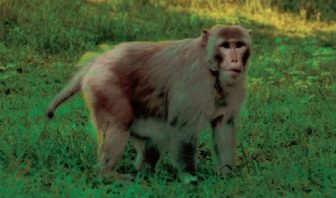Old World monkeys (OWMs) are one of two major groups of monkeys, consisting of all primates belonging to the family Cercopithecidae. The family is composed of 18 genera and approximately 90 species, including baboons, colobines, guenons, and macaques.
OWMs are found throughout large portions of Africa and Asia, living in a wide range of habitats. They range from the savannas of Africa, to the tropical rain forests of Indonesia, to the snowy regions of Japan. Most OWMs are arboreal (tree dwellers), whereas some are terrestrial (ground dwellers). OWMs are nearly completely diurnal, meaning that they are active during daylight hours. Group structures among OWMs vary greatly. Most species live in social groups that consist of several adult males and females with their offspring.
Certain physical traits characterize OWMs. They are medium to large primates with body sizes ranging from 1 to 40 kilograms. They do not possess a prehensile tail like the other major group of monkeys (New World monkeys). OWMs’ forelimbs are shorter than their hindlimbs and are characterized by narrow elbow joints. They are quadrupedal animals, meaning that they use all four limbs to loco-mote. OWMs have a narrow nose with a narrow palate. They also have four cusps on their molars that form two parallel ridges called bilophodont. Most species of OWMs have special sitting pads on their behinds called ischial callosities. In addition, many size, meaning that the males are larger than the females of the same species.
 The earliest fossil evidence of OWMs comes from remains of the family Victoriapithecidae and dates to the early Miocene (approximately 20 million years ago) in Africa. The family Cercopithecidae is divided into two distinct subfamilies based on features related to dietary adaptations. The first subfamily, Cercopithecinae, is composed of guenons and papionins. The latter group includes baboons, mangabeys, and macaques. The cercopithecines are omnivorous and have cheek pouches in which they can store food temporarily. Guenons, baboons, and mangabeys are exclusive to Africa. Macaques, on the other hand, are found predominantly in Asia. The second subfamily, Colobinae, is divided geographically. The colobines in Africa are referred to as colobus monkeys, whereas those in Asia are referred to as langurs or leaf monkeys. This is because their diets consist nearly entirely of leaves and unripe fruits and nuts. As such, they have a highly specialized, cow-like stomach that allows them to digest the cellulose in leaves.
The earliest fossil evidence of OWMs comes from remains of the family Victoriapithecidae and dates to the early Miocene (approximately 20 million years ago) in Africa. The family Cercopithecidae is divided into two distinct subfamilies based on features related to dietary adaptations. The first subfamily, Cercopithecinae, is composed of guenons and papionins. The latter group includes baboons, mangabeys, and macaques. The cercopithecines are omnivorous and have cheek pouches in which they can store food temporarily. Guenons, baboons, and mangabeys are exclusive to Africa. Macaques, on the other hand, are found predominantly in Asia. The second subfamily, Colobinae, is divided geographically. The colobines in Africa are referred to as colobus monkeys, whereas those in Asia are referred to as langurs or leaf monkeys. This is because their diets consist nearly entirely of leaves and unripe fruits and nuts. As such, they have a highly specialized, cow-like stomach that allows them to digest the cellulose in leaves.
De Brazza’s monkeys (Cercopithecus neglectus) are one of the more recognizable guenons due to their unique facial hair and white beard. Some well-known papionin species include the sometimes snow-dwelling and hot spring-bathing Japanese macaques (Macaca fuscata) and brightly colored mandrills (Mandrillus sphinx). Long-haired Eastern black-and-white colobus monkeys (Colobus guereza) are notable African colobines. Most well known among the Asian leaf monkeys are the well-studied Hanuman langurs ( Semnopithecus entellus) from India and the very large-nosed proboscis monkeys (Nasalis larvatus) of Borneo. Because of habitat loss and hunting, approximately one third of OWMs are endangered.
References:
- Fa, J. E., & Lindburg, D. G. (Eds.). (1996). Evolution and ecology of macaque societies. Cambridge, UK: Cambridge University Press.
- Fleagle, J. G. (1999). Primate adaptation and evolution. San Diego: Academic Press.
- Glenn, M., & Cords, M. (Eds.). (2002). Theguenons: Diversity and adaptation in African monkeys. New York: Kluwer Academic/Plenum.
- Oates, J. F., & Davies, A. G. (Eds.). (1994). Colobine monkeys: Their ecology, behaviour, and evolution. Cambridge, UK: Cambridge University Press.
- Rowe, N. (1996). The pictorial guide to the living primates. Charlestown, RI: Pogonias Press.
Whitehead, P, F., & Jolly, C. J. (2000). Old World monkeys. Cambridge, UK: Cambridge University Press.

